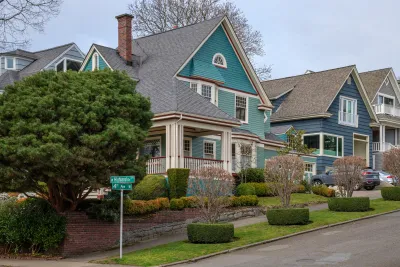Form-based zoning codes can encourage mixed-use development and walkable neighborhoods, but focusing too much on aesthetic elements can drive up the cost of housing.

Writing in The Urbanist, Ryan DiRaimo explains form-based codes, which Seattle is exploring as part of the city’s effort to reform its zoning code.
According to DiRaimo, “The great thing about a form-based code is that it allows things like coffee shops, bookstores, corner stores, and small retail to mix in with the neighborhoods previously zoned exclusively for residential. With a form-based code’s flexibility for land-use, we can finally have vibrant, walkable neighborhoods again.”
However, DiRaimo warns, “where a form-based code fails is when it is used to mandate aesthetic details that have little impact on improving the quality of the public realm—the very purpose of form-based code’s existence.” Pointing to a recently passed state bill, DiRaimo writes that regulating design and aesthetics too much can be “overly prescriptive” and discourage creativity in design.
“With the clock running out on Seattle’s planning process, there is a deep concern that form-based code adoption will include prescriptive design regulations because it’s an established element of the code according to a consultant who has already completed a template.” For DiRaimo, “The eclectic mix of different styles of buildings is what makes Seattle neighborhoods interesting and desirable,” and reviewing every small aesthetic detail won’t improve affordability.
“We need fewer rules and better processes,” DiRaimo concludes. “And since housing is almost never a charity, the aesthetic rules will only kill building plans, limit housing supply, and segregate who can afford to move into the neighborhood.”
FULL STORY: Op-Ed: Off-Base Form-Based Codes Could Be Headed to Seattle

National Parks Layoffs Will Cause Communities to Lose Billions
Thousands of essential park workers were laid off this week, just before the busy spring break season.

Retro-silient?: America’s First “Eco-burb,” The Woodlands Turns 50
A master-planned community north of Houston offers lessons on green infrastructure and resilient design, but falls short of its founder’s lofty affordability and walkability goals.

Delivering for America Plan Will Downgrade Mail Service in at Least 49.5 Percent of Zip Codes
Republican and Democrat lawmakers criticize the plan for its disproportionate negative impact on rural communities.

Test News Post 1
This is a summary

Test News Headline 46
Test for the image on the front page.

Balancing Bombs and Butterflies: How the National Guard Protects a Rare Species
The National Guard at Fort Indiantown Gap uses GIS technology and land management strategies to balance military training with conservation efforts, ensuring the survival of the rare eastern regal fritillary butterfly.
Urban Design for Planners 1: Software Tools
This six-course series explores essential urban design concepts using open source software and equips planners with the tools they need to participate fully in the urban design process.
Planning for Universal Design
Learn the tools for implementing Universal Design in planning regulations.
EMC Planning Group, Inc.
Planetizen
Planetizen
Mpact (formerly Rail~Volution)
Great Falls Development Authority, Inc.
HUDs Office of Policy Development and Research
NYU Wagner Graduate School of Public Service





























